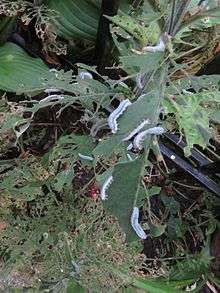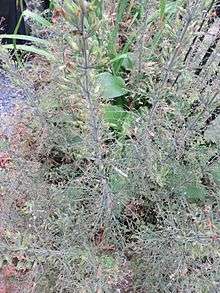Lysimachia terrestris
| Lysimachia terrestris | |
|---|---|
.jpg) | |
| Scientific classification | |
| Kingdom: | Plantae |
| (unranked): | Angiosperms |
| (unranked): | Eudicots |
| (unranked): | Asterids |
| Order: | Ericales |
| Family: | Primulaceae |
| Genus: | Lysimachia |
| Species: | L. terrestris |
| Binomial name | |
| Lysimachia terrestris (L.) Britton, Sterns & Poggenb. | |
| Synonyms[1] | |
| |


Lysimachia terrestris (swamp candles, lake loosestrife[2] or earth loosestrife) is a plant[3] in the Primulaceae family.
Description
Lysimachia terrestris is a herbaceous plant with opposite, simple leaves, and erect stems. The flowers are produced in a raceme, 10–30 cm (4–12 in) long, at the top of the plant.[4] The flowers are star-shaped with five yellow petals, and appear in mid-summer. Each petal has two red dots at its base forming a circle of ten red dots in the center of the flower.
Ecology and distribution
Lysimachia terrestris grows in swamps and at the edges of ponds and lakes in the Eastern United States and in Eastern Canada. It is also found in the U.S. states of Oregon, Washington, and Idaho, and in British Columbia.[4] It is listed as endangered in Tennessee and Kentucky.
A major pest is Monostegia abdominalis, a sawfly larva that can completely skeleonize the leaves.
References
- ↑ "Lysimachia terrestris". The Plant List: a Working List of All Plant Species. Retrieved 25 June 2015.
- ↑ "BSBI List 2007". Botanical Society of Britain and Ireland. Archived from the original (xls) on 2015-02-25. Retrieved 2014-10-17.
- ↑ Harry C. Lund (1999). Michigan Wildflowers in Color. Holt, MI: Thunder Bay Press. ISBN 978-1-88237-656-8.
- 1 2 Anita F. Cholewa (2009). "Lysimachia". Magnoliophyta: Paeoniaceae to Ericaceae. Flora of North America. 8. Oxford University Press. pp. 302–318. ISBN 978-0-19-534026-6.
External links
 Media related to Lysimachia terrestris at Wikimedia Commons
Media related to Lysimachia terrestris at Wikimedia Commons- USDA PLANTS Profile
- Lady Bird Johnson Wildflower Center